Playing with intuitive zines as NaNoWriMo prep.
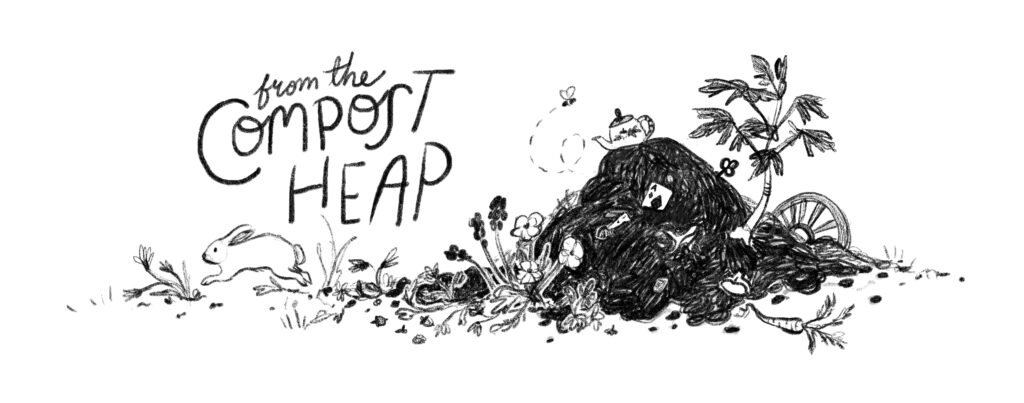
-
Read more: untitled post 156079401
“A writer is a person who cares what words mean, what they say, how they say it. Writers know words are their way towards truth and freedom, and so they use them with care, with thought, with fear, with delight. By using words well they strengthen their souls.”
Ursula K. Le Guin
-
Read more: untitled post 156079261
“I’ve come to understand that not everything I write needs to go somewhere. But the act of writing itself—of witnessing—does something to me. It organizes what I didn’t know I was trying to understand. It shows me what I’m circling, what I’m avoiding, what I already know.
Writing, self-publishing, and small acts of attention help me keep my heart from hardening. They’re not solutions—but they’re part of how I stay human.”
-
From Where You Dream
Read more: From Where You Dreamby Robert Olen Butler
“Please get out of the habit of saying that you’ve got an idea for a short story. Art does not come from ideas. Art does not come from the mind. Art comes from the place where you dream. Art comes from your unconscious; it comes from the white hot center of you.”
The concept of this book is that storytelling comes from your unconscious and not your logical mind. This tracks with the writing process of Ray Bradbury, Dorothea Brande, even Terry Pratchett. It also maps onto the concepts of “day brain” vs. “night brain” writing explored on the podcast Writing Excuses.
But the farther I read into this book the more rigid and didactic Butler’s approach seemed. He needlessly used plot examples requiring a content warning.
I can’t say I wholeheartedly recommend this book, but I do find this concept of taking space to “dream” a story before you write it both liberating and extremely challenging. After setting an intention for more reverie in 2025 I have instead completely rebuilt my website and migrated my newsletter. 🤷
But my best fiction has come from that place of the unconcious. So this is a technique I want to explore.
If you do read this book, take it with a grain of salt. Artists often sound as if their way is the only way because it is the way that works for them.
For their creative ecosystem.
What you or I need may be completely different.
With those caveats here are some passages I found interesting.
“Voice is the embodiment in language of the contents of your unconscious.”
Most artists spend a lot of time and energy trying to find / discover / hone their artistic voice or style. Whereas this suggests that leaning away from analysis and toward the unconscious may bring you closer to your true voice.
“What you forget goes into the compost of the imagination… in a compost heap, things decompose. Your past is full of stories that have been composed in a certain way; that’s what memories are. But only when they decompose are you able to recompose them into new works of art.”
Love a creative compost metaphor of course. He is paraphrasing British novelist Graham Greene here.
“The organic nature of art is such that within the process everything must be utterly malleable, utterly fluent, so that everything ultimately can be brought together; and if there’s anything in there that will not yield, is not open to change, you cannot create the object.”
This is something I’m finding in my own process. I come in with a concept for a story, but the more closely I hold myself within those bounds the worse the writing is. This past year my writing started to enter this dreamspace for the first time. I found the story was moving like shifting tetonic plates.
“Rewriting is redreaming.”
I think the most radical idea in this book is that even editing (normally considered an analytical process) can come from the unconscious.
And should in Butler’s opinion.
As a literature professor he has all the tools for analysis, but claims not to consciously use them. He rereads his books looking for “twangs” and redreams them until it all “thrums.” Even his rewriting process coming from the unconscious.
“The compost heap of the novelist, the repository that exists apart from literal memory, apart from the conscious mind, is mostly made up of direct, sensual life experience.”
More creative compost. Butler has an obsession with sensory details and decries all explanatory words (for emotions, etc.) and here is where you can fall into the trap of taking on his style for your own. Centering on sensory details can certainly make a text richer, but to use them exclusively feels extreme.
It’s a stylistic choice not “good” or “bad” writing as he frames it.
“[Fiction and technique] must first be forgotten…before they can be authentically engaged in the creation of a work of art.”
He’s basically explaining here that all of that analysis (of stories and literature and writing technique) goes in the compost heap and he doesn’t trust it until it’s filtered through dreamspace.
“Desire is the driving force behind plot.”
I think this comes to the heart of his dreamspace technique. Rather than plotting a work analytically (something I am apparently allergic to) he let’s the objective of a character drive the action. This prevents the awkward situation where a character simply does something because the plot requires it.
It’s a bit chicken and the egg.
I don’t think one way is right or wrong. But when you’re done your character had darn well better have a drive for what they are doing. But doesn’t it sound more fun to let character drive your writing rather than the other way around.
“Writers who aspire to a different kind of fiction— entertainment fiction, let’s call it, genre fiction—have never forgotten this necessity of the character’s yearning.”
He is a straight up literary snob here. 🙄
But it’s worth mentioning because this chapter reminded me of musical theatre structure.
Something strongly present in my personal compost heap.
There’s always an “I want” song in Act I.
“[The artist] doesn’t know what she knows about the world until she creates the object… the writing of a work of art is as much an act of exploration as it is expression, an exploration of images, of moment-to-moment sensual experience.”
I think a lot of writers sit down to “write a book” not to “discover a story.”
For all of my criticisms of this book I do think I’ve added some rich humus (with a pile of horse 💩) to my compost heap.
That said, I hesitate to give Butler too much credit. The reason I bought his book was that I was already curious about a more intuitive approach based on Ray Bradbury’s Zen and the Art of Writing.
I gave up marking quotes because I wanted to quote every other line. And ended up too intimidated to write about it at all. Which now feels silly because I’m writing about this book that is a dim reflection of it.
Bradbury very much wrote from this dreamspace and drawing images and characters from his unconcious. I just need to find the fortitude to do it justice when writing about it.
Maybe next month.
Photo Credit: Patrick McManaman
-
My Novel’s Mood Board
Read more: My Novel’s Mood BoardWorks in Progress
I’m currently in deep ideation and research mode for a fantasy novel. The working title is Mawd for one of the characters (named after Lucy Maud Montgomery – author of Anne of Green Gables.)
Here’s a timelapse of the mood board I’m creating.
You can browse the virtual mood board and see image sources on are.na.
Find snippets of my research here and here.
I’ll be sharing more about my writing process over at The Writing Desk.
-
Read more: untitled post 576
Caught up on my novel writing.
-
Read more: untitled post 539
Writing my way out.
-
Draft no. 4
Read more: Draft no. 4by John McPhee
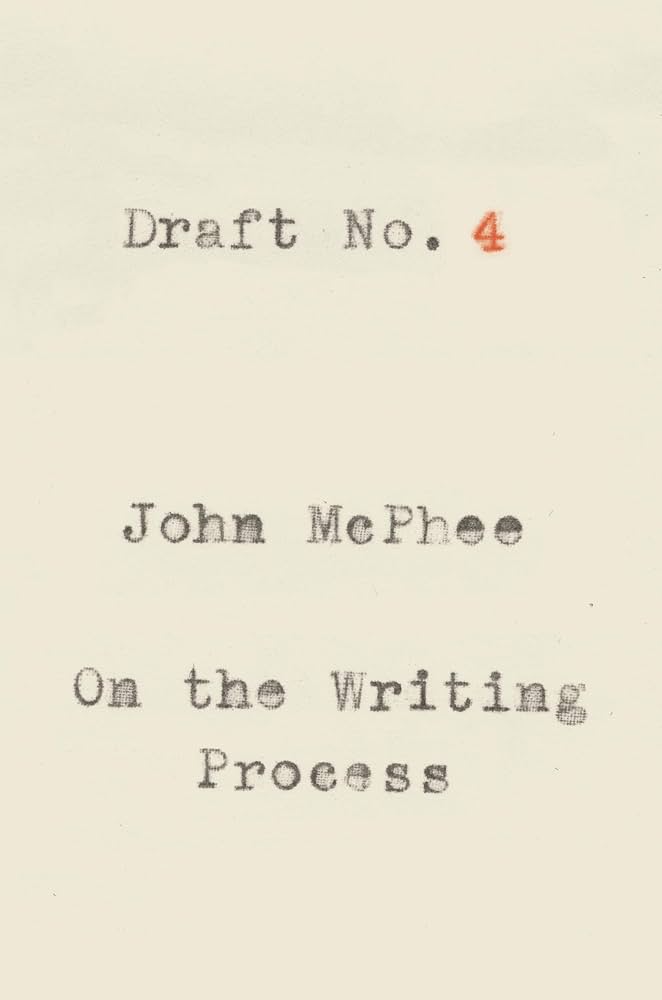
This book is half writing craft / half memoir. Here are some of his gem’s about writing.
First, one of the graphs that inspired me to buy the book. I am fascinated how he thinks so visually about his structural process.
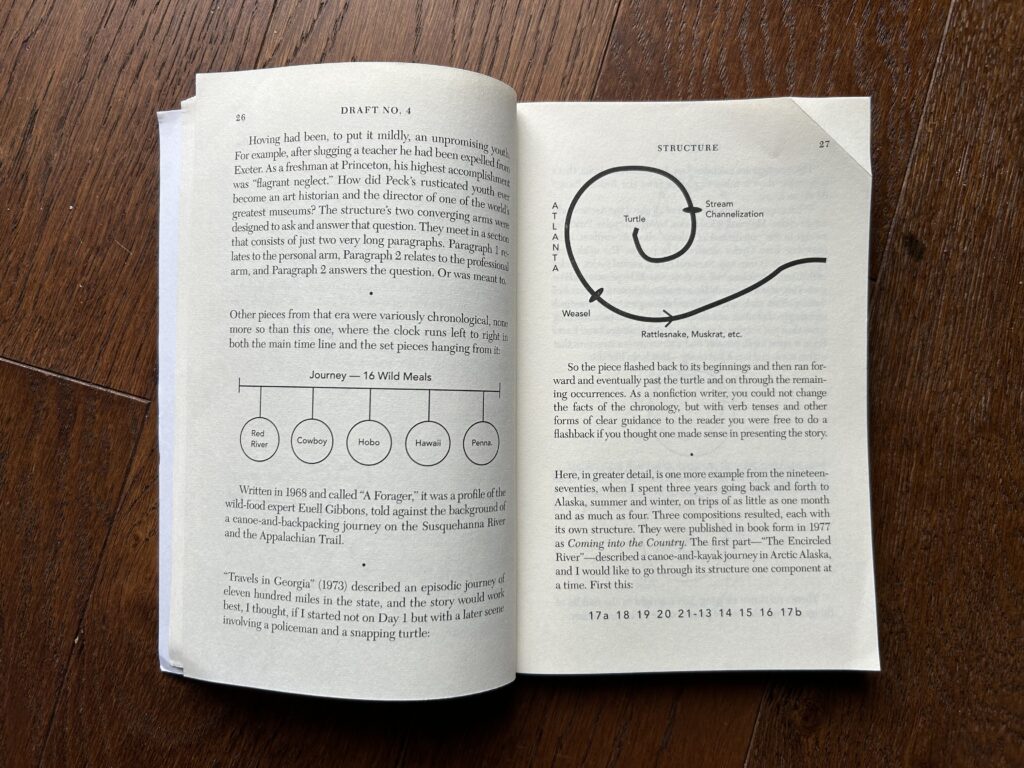
(The book was second hand and dog eared when I bought it.)Notes on Structure
Almost always there is considerable tension between chronology and theme, and chronology traditionally wins.
McPhee is talking about non fiction here, but this is doubly true for novels.
Readers are not supposed to notice the structure. It is meant to be about as visible as someone’s bones.
a basic criterion for all structures: they should not be imposed upon the material. They should arise from within it.
This is a very actionable step.
Often, after you have reviewed your notes many times and thought through your material, it is difficult to frame much of a structure until you write a lead. You wade around in your notes, getting nowhere. You don’t see a pattern. You don’t know what to do. So stop everything. Stop looking at the notes. Hunt through your mind for a good beginning. Then write it. Write a lead.
I would go so far as to suggest that you should always write your lead (redoing it and polishing it until you are satisfied that it will serve) before you go at the big pile of raw material and sort it into a structure.
I wonder if writing a novel that is underpinned with research and note making could move forward similarly to the process of writing non fiction. I’m curious about this as I am someone who is more comfortable writing non fiction and trying to find my feet with novels.
The lead—like the title—should be a flashlight that shines down into the story. A lead is a promise. It promises that the piece of writing is going to be like this. If it is not going to be so, don’t use the lead.
More stunning imagery. I love the idea of the lead as a flashlight shining down through a story.
Another way to prime the pump is to write by hand… get away from the computer, lie down somewhere with pencil and pad, and think it over. This can do wonders at any point in a piece and is especially helpful when you have written nothing at all. Sooner or later something comes to you. Without getting up, you roll over and scribble on the pad. Go on scribbling as long as the words develop. Then get up and copy what you have written into your computer file.
Another actionable tip. And yet acknowledging what works for him is not universal:
Alternating between handwriting and computer typing almost always moves me along, but that doesn’t mean it will work for you.
Finding Your Style
Young writers find out what kinds of writers they are by experiment.
If they choose from the outset to practice exclusively a form of writing because it is praised in the classroom or otherwise carries appealing prestige, they are vastly increasing the risk inherent in taking up writing in the first place. It is so easy to misjudge yourself and get stuck in the wrong genre.
You avoid that, early on, by writing in every genre. If you are telling yourself you’re a poet, write poems. Write a lot of poems. If fewer than one work out, throw them all away; you’re not a poet. Maybe you’re a novelist. You won’t know until you have written several novels.
This is so interesting. Particularly the bit about getting stuck writing in a way that was praised in school.
Young writers generally need a long while to assess their own variety, to learn what kinds of writers they most suitably and effectively are…
“Though a man be more prone and able for one kind of writing than another, yet he must exercise all.” Ben Jonson
One of my favorite quotes in the book.
No one will ever write in just the way that you do, or in just the way that anyone else does. Because of this fact, there is no real competition between writers. What appears to be competition is actually nothing more than jealousy and gossip. Writing is a matter strictly of developing oneself. You compete only with yourself. You develop yourself by writing. An editor’s goal is to help writers make the most of the patterns that are unique about them.
On omission and selection,
Writing is selection.
… You select what goes in and you decide what stays out. At base you have only one criterion: If something interests you, it goes in—if not, it stays out.
… Forget market research. Never market-research your writing. Write on subjects in which you have enough interest on your own to see you through all the stops, starts, hesitations, and other impediments along the way. Ideally, a piece of writing should grow to whatever length is sustained by its selected material—that much and no more.
Drafting
McPhee on the difference between drafts and a ratio of how long each draft takes that he observed in his own writing over time.
First drafts are slow and develop clumsily because every sentence affects not only those before it but also those that follow. The first draft of my book on California geology took two gloomy years; the second, third, and fourth drafts took about six months altogether. That four-to-one ratio in writing time—first draft versus the other drafts combined—has for me been consistent in projects of any length, even if the first draft takes only a few days or weeks. There are psychological differences from phase to phase, and the first is the phase of the pit and the pendulum. After that, it seems as if a different person is taking over. Dread largely disappears. Problems become less threatening, more interesting. Experience is more helpful, as if an amateur is being replaced by a professional. Days go by quickly and not a few could be called pleasant, I’ll admit.
I’m intrigued to see him using the same metaphor as Neil Gaiman [[Throwing Mud at the Wall]]. I wonder who said it first and if one is referencing the other or if it arose naturally because it is so fitting to the task at hand.
The way to do a piece of writing is three or four times over, never once. For me, the hardest part comes first, getting something—anything—out in front of me. Sometimes in a nervous frenzy I just fling words as if I were flinging mud at a wall.
And in a letter to his daughter (writer Jenny McPhee),
You finish that first awful blurting, and then you put the thing aside. You get in your car and drive home. On the way, your mind is still knitting at the words. You think of a better way to say something, a good phrase to correct a certain problem. Without the drafted version—if it did not exist—you obviously would not be thinking of things that would improve it. In short, you may be actually writing only two or three hours a day, but your mind, in one way or another, is working on it twenty-four hours a day—yes, while you sleep—but only if some sort of draft or earlier version already exists.
In another letter to Jenny,
Dear Jenny: What am I working on? How is it going? Since you asked, at this point I have no confidence in this piece of writing. It tries a number of things I probably shouldn’t be trying. It tries to use the present tense for the immediacy that the present tense develops, but without allowing any verb tense to become befouled in a double orientation of time. It tells its story inside out. Like the ship I’m writing about, it may have a crack in its hull. And I’ve barely started. After four months and nine days of staring into this monitor for what has probably amounted in aggregate to something closely approaching a thousand hours, that’s enough. I’m going fishing.”
Fiction
Art is where you find it. Good writing is where you find it. Fiction, in my view, is much harder to do than fact, because the fiction writer moves forward by trial and error, while the fact writer is working with a certain body of collected material, and can set up a structure beforehand.
“Fiction must stick to facts, and the truer the facts the better the fiction—so we are told.” Virginia Woolf, A Room of One’s Own.
Editing
An editing tip he uses himself and taught his students at Stanford,
You draw a box not only around any word that does not seem quite right but also around words that fulfill their assignment but seem to present an opportunity.
While the word inside the box may be perfectly O.K., there is likely to be an even better word for this situation, a word right smack on the button, and why don’t you try to find such a word? If none occurs, don’t linger; keep reading and drawing boxes, and later revisit them one by one. If there’s a box around “sensitive” because it seems pretentious in the context, try “susceptible.” Why “susceptible”? Because you looked up “sensitive” in the dictionary and it said “highly susceptible.” With dictionaries, I spend a great deal more time looking up words I know than words I have never heard of—at least ninety-nine to one. The dictionary definitions of words you are trying to replace are far more likely to help you out than a scattershot wad from a thesaurus.
On knowing when he is done,
When am I done? I just know. I’m lucky that way. What I know is that I can’t do any better; someone else might do better, but that’s all I can do; so I call it done.
William Shawn, McPhee’s Editor at The New Yorker when asked how he has so much time to work with each writer on the smallest details,
“It takes as long as it takes.”
McPhee’s advice on maintaining your voice when working with editors,
There are people who superimpose their own patterns on the work of writers and seem to think it is their role to force things in the direction they would have gone in if they had been doing the writing. Such people are called editors, and are not editors but rewriters.
My advice is, never stop battling for the survival of your own unique stamp. An editor can contribute a lot to your thoughts but the piece is yours—and ought to be yours—if it is under your name.
And then on how invaluable editors can be,
Editors are counselors and can do a good deal more for writers in the first-draft stage than at the end of the publishing process.
The help is spoken and informal, and includes insight, encouragement, and reassurance with regard to a current project.
Confidence and Imposter Syndrome
If you lack confidence in setting one word after another and sense that you are stuck in a place from which you will never be set free, if you feel sure that you will never make it and were not cut out to do this, if your prose seems stillborn and you completely lack confidence, you must be a writer.
And unless you can identify what is not succeeding—unless you can see those dark clunky spots that are giving you such a low opinion of your prose as it develops—how are you going to be able to tone it up and make it work?
This is encouraging because this is the same reframe I used when returning to fiction writing after giving it up. If I see the problems I can work on fixing them.
Notes on Technology
Howard thought the computer should be adapted to the individual and not the other way around. One size fits one.
Howard was a computer programmer who helped McPhee customize the software he used.
Hat Tip to Austin Kleon
-
Rekindling a Note Taking Practice
Read more: Rekindling a Note Taking PracticeI’ve always loved note taking.
Even as a kid I would collect notes and information, magazine pages, booklets. I think it’s something of a neurodivergent impulse. Autistic folks often love collecting things and I’ve only just realized that part of that drive for me is in collecting information. I love learning things, but I also love cataloguing what I’m learning.
(Important to note this is not a universal love among autistics. There are a lot of different ways our passions and interests can show up.)
Through the years I’ve tried on different styles of note taking, but I’ve always loved the idea of a centralized system. The problem is I kept trying on other people’s systems and they were never the quite right fit.
Recently, I’ve been working out how to create my ideal note taking system.
A caution, dear reader, not to try and recreate my own system for yourself. But I hope by sharing this it can shatter some misconceptions about research and note taking and open up the realm of possibilities to you.
If you’ve been around for a while you’ll notice this is kind of an amalgamation of several different note taking projects I have had. Gathering up everything under one roof as it were. Over the years I have tried: physical notebooks, file folders, the Pocket app, Evernote app, traveler’s notebooks, blog posts, podcasts, Notion, and finally a library card catalogue drawer. Each of those attempts was, in a way, trying to create a system that I saw outside of myself and they were all too rigid.
My new system is a digital analogue hybrid.
I love handwriting notes. Typing them. Shuffling around papers. For years my ideal system (the one of my university mentor) was a series of matching composition notebooks. (1)
Then it was digital. I went “all in” on Evernote and it didn’t take long to reach the threshold where they wanted to charge a monthly fee. I think I was between degrees at this point and couldn’t imagine paying for that so I pivoted back to paper again.
Austin Kleon blogged about commonplace books and I was hooked. I tried to create a color coded indexing system. I tried numerical systems.

The trouble with notebooks is no matter what kind of system you use it can be hard to find what you’ve recorded in the past. (2)
After a while I gave up on that and started sharing monthly updates on Patreon. A round up of everything I’ve read, watched, or listened to with some of my favorite quotes.
I always circle back to physical though. Early 2019 I tried a physical notebook to document what I wanted to share to Patreon. This was shortly before Davy was born and it quickly went out the window.

But the digital format survived. It lives on as my newsletter.
The trouble is when I’m really in research collecting mode I have more than I can reasonably share in this format. And it’s also not easily search-able.
So in 2020 I started a Notion. That also has stuck with me, but there are some caveats.
- It’s a third party app that could disappear or start charging at any moment.
- And I haven’t kept up with cataloguing the details like I did in the beginning and it’s starting to become a bit of a tangled mess.
Part of the problem is I created this system when Davy was still napping in my lap a lot. So I had ages to poke around on my phone. Now I have other things to do and this type of cataloguing is not at my top of priorities. Here’s a screenshot where you can see I no longer take the time to fill out “by” and “type” which are kind of essential when it comes to finding what I’m looking for.)
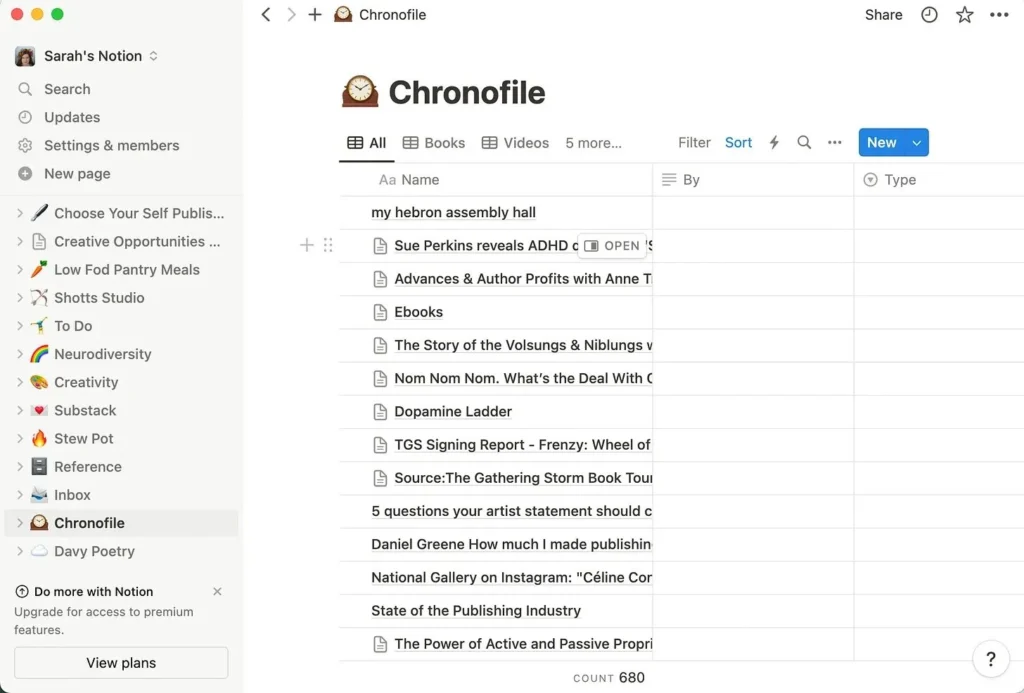
So I swing back analogue…
When Davy started school I read yet another book about note taking and I fell in love with the idea of writing or typing up all my notes on index cards in my “free time.” But Davy was only in school for half days and by the time you take the commute into account I was lucky to get a couple of hours each day. I spent most of them writing a book and making art.
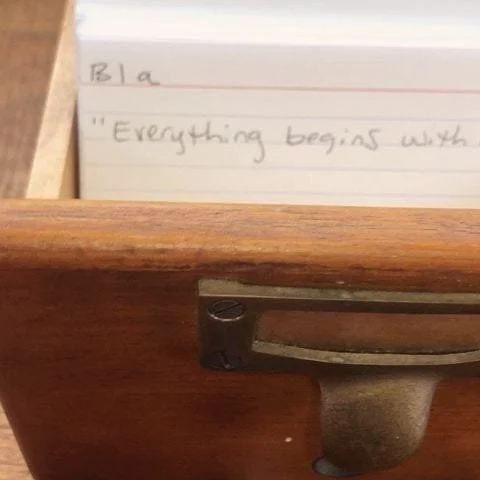
Now we’re home educating so it’s all a muddle of life and creativity without any clearly delineated “studio time.
If you’re neurodivergent you may have a similar cycle…
Get excited by a project.
Find a creative spark to create a system.
Abandon system.
Feel guilty.
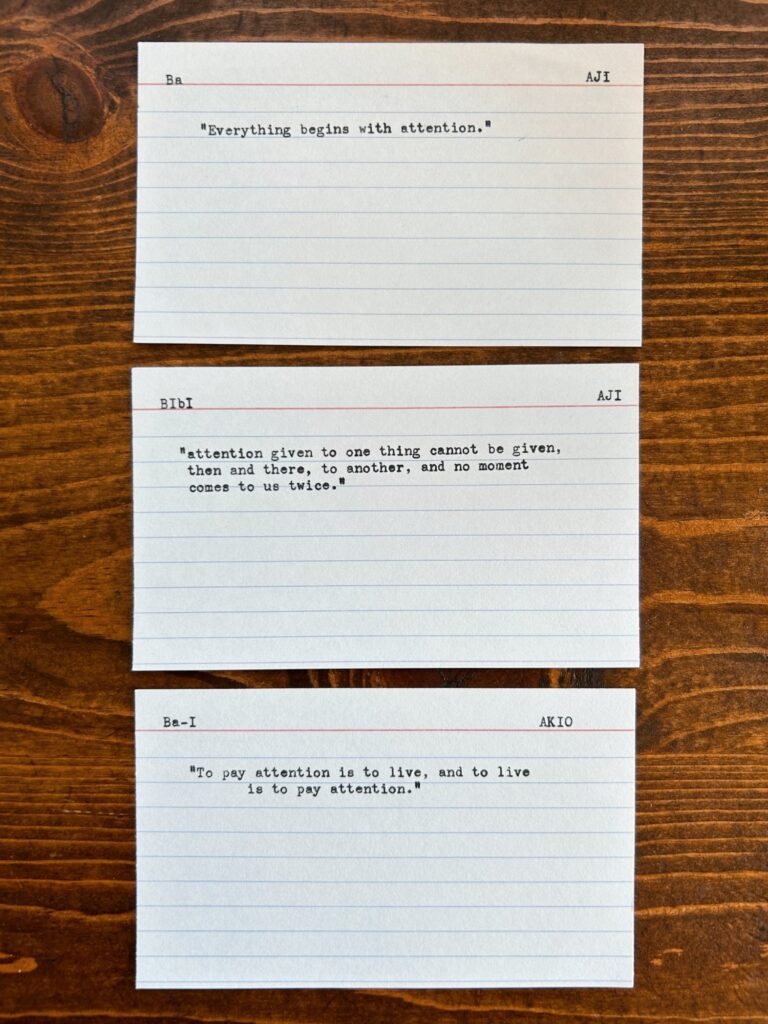
But something was different this time around.
In all of the research about neurodiversity and autism to support David I am learning to support myself. And to reframe my perceived “deficits” as differences.
Instead of feeling guilty I got curious.
Why did some methods work better than others? What would really work best for me?
When I switched up my Substack schedule I freed up some mental bandwidth.
That extra capacity is really key here. I rarely innovate when I’m at capacity.
The second magic ingredient was playing around.
I was reading a new book and wanted to take notes. Instead of using Notion I followed my impulse and wrote them up on index cards. I knew it wasn’t something I could maintain, but I did it anyway.
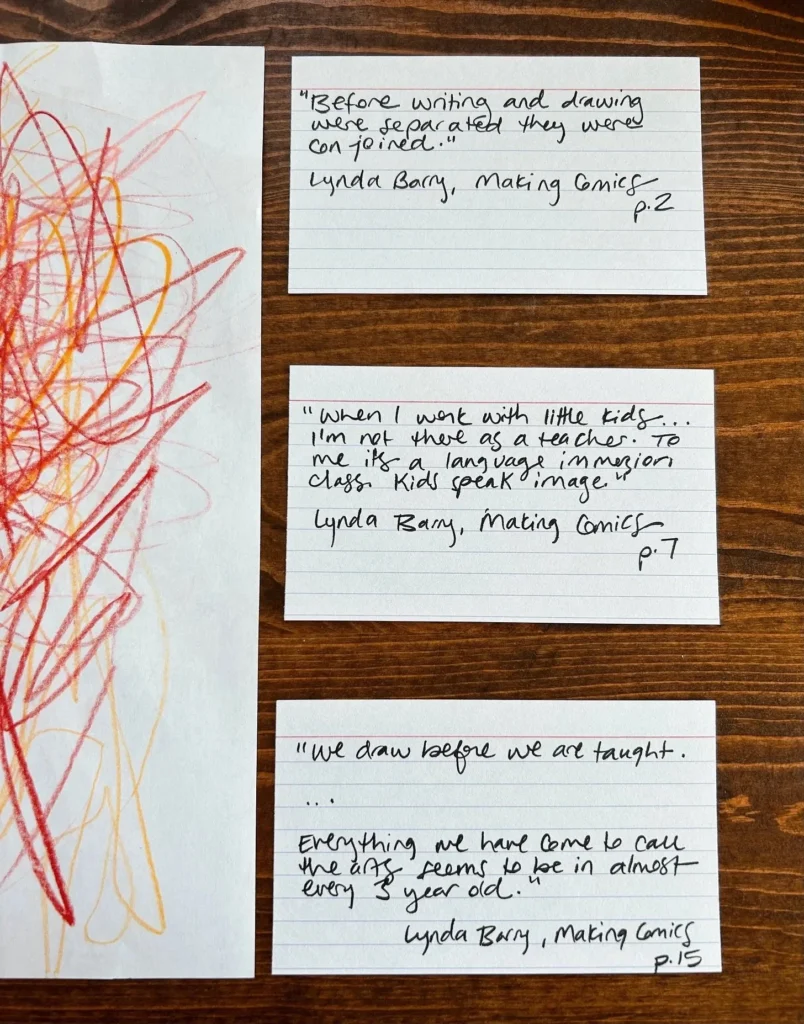
Kids Speak Image, Lynda Barry, September 20, 2023
Meanwhile I’d been thinking about how to document and share content in a more casual way online. The weekly Substack posts had been too time consuming, but I knew if I slowed my publishing schedule to monthly (or even fortnightly) I would have so much I wanted to share and document in the in between.
Then Austin Kleon linked to his Tumblr. I played around with a Tumblr account for a couple weeks and fell in love with the ease of it.
- Find something lovely.
- Share it.
- Type in some tags.
It didn’t take long for me to see the caveats though.
Mostly I was still creating content for someone else’s machine. Tumblr is old (in internet years) and who knows how long it will be around. Also, people started seeing and liking my posts and I was afraid I might start feeling social media feels about the value of posts based on their engagement.
But there were also things I loved about it! One of which was how visual it was! My brain loves scrolling through a visual archive versus something that looks like a giant excel sheet (no offense Notion.)
What I needed was a private Tumblr. Somewhere I could archive notes, images, even videos or podcasts. With a simple tagging system.
Enter the microblog.
I’m not sure how long it took me to realize that I could just make this on my own website.
Not a blog, but a microblog. My blog is a place to share long form writing with other people. Whereas this microblog is a collection of bits and bobs. A place to archive research and document my creative process as a tool for myself. Which I might sometimes point to.

I love it.
It feels like such a simple way to make a visual record of my thoughts and ideas. If you scroll through it’s essentially like taking a peek inside my brain. What am I reading? What am I thinking about? What was the obsession of the day?
I am fascinated by the process of ideas unfolding and layering and coming alive. It’s something I’m always unraveling when I look at other people’s work and it’s part of why I love following artists and creators online. (3)
What I got stuck on was the name. At first I called it scraps, but that didn’t really fit. Eventually I realized the answer had been there all along.
Welcome to the Chronofile
Sometime along the way I started calling my notes “The Chronofile.” You can see the hashtag in early Instagram posts and a note taking folder on Notion.
The name come from one of my creative muses – Buckminster Fuller.
He was a brilliant inventor and artist and writer and is known largely as the creator of the geodesic dome. I could go on and on about him (and I probably will some other time) but for now I’ll explain that he too was an obsessive notetaker. He documented everyday of his life in something he called the Dymaxion Chronofile. His file includes “more than 140,000 papers and 1,700 hours of audio and video” (all of which are archived in physical form and take up 1,400 linear feet.) (4)
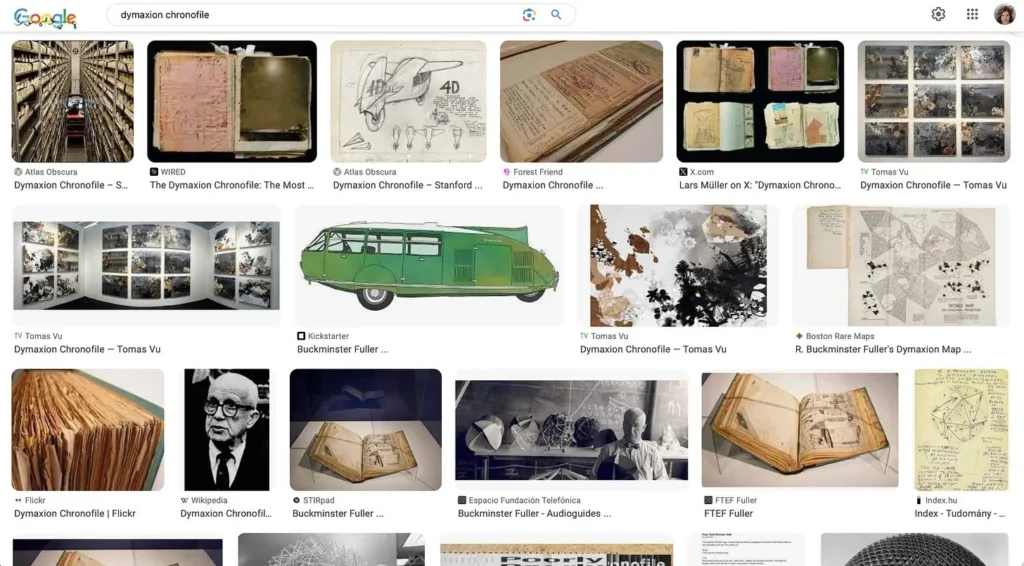
Google Search results for “dymaxion chronofile” December 4, 2023
All the more reason to go digital! I do not have that kind of space. 😂
But there’s something about analogue.
Writing things down engages a different part of the brain than typing. (5)
Not to mention the physical record and embodied act of moving around notes and seeing them in visual conversation with each other.
What I happened upon by writing those notes about Lynda Barry’s books was that I can have the best of both worlds.
Physical notecards of my favorite quotes – in a card catalogue drawer, and a searchable digital archive – hosted on my own website.
I can easily type up notes on my phone (using the Squarespace app) and then later jot them down or type them onto a card for my physical file. This also adds a layer of curation for my physical chronofile.
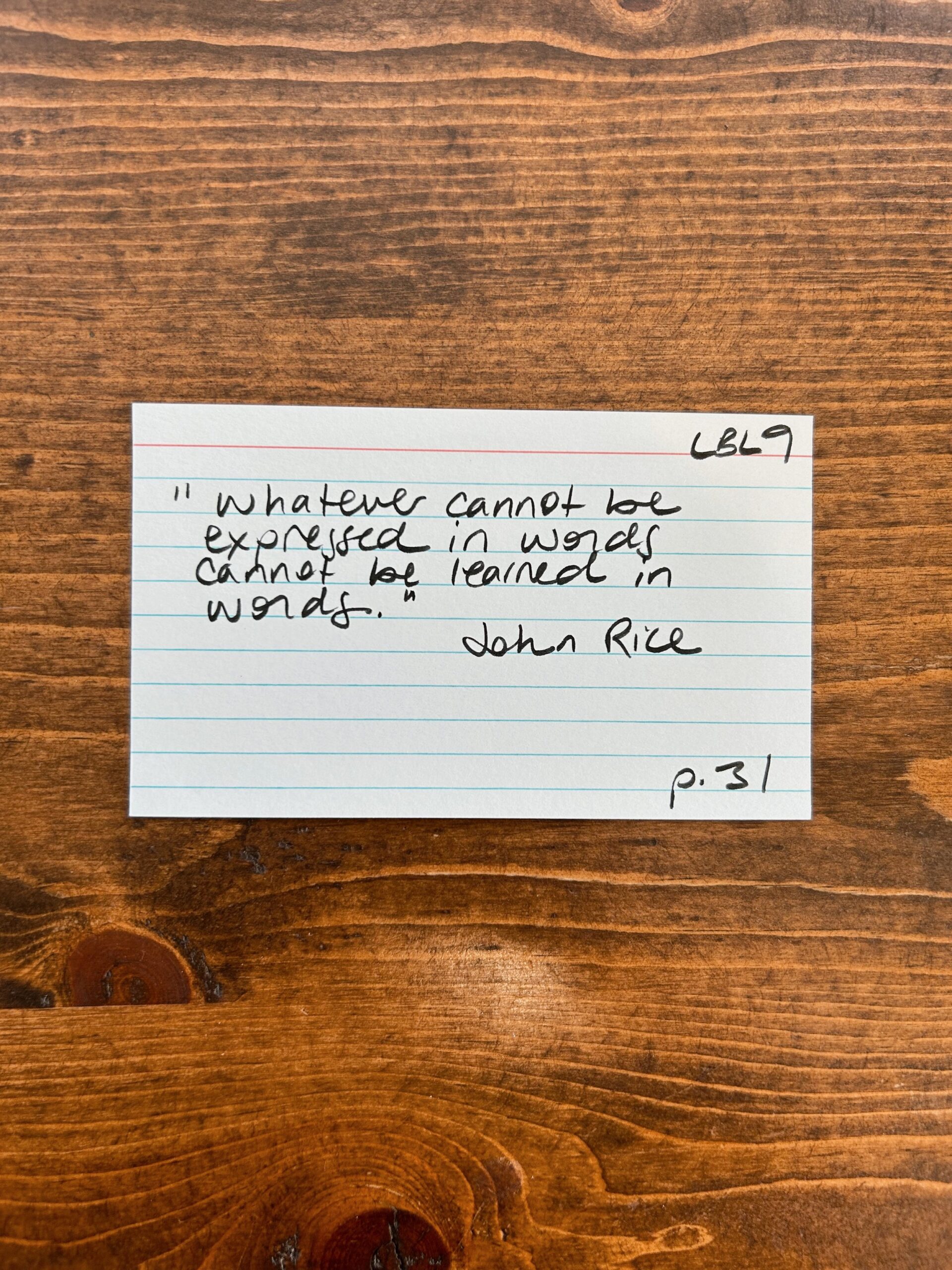
It also means the letter and number codes (used above) are largely irrelevant due to the search-ability of my digital chronofile. Which is quite a relief because they never felt natural – just another outside system I was trying to use to reinvent the wheel. Why create analogue reference systems when digital search does that so easily?
I fully accept this process will shift and change. But what I’m trying to do is to utilize the best features of each medium.
Analogue for muscle memory. For embodiment. For serendipitous connections. And for aesthetic share-ability.
Digital for search-ability. For time lord technology (fitting a lot in quite a small physical space). And for the ability to include photos, videos, and audio files.
Embracing my inner Magpie
The real delight here is that scaling back my Substack publishing schedule has freed up bandwidth to rekindle my passion for research.
From deep dives into artist communities like Black Mountain College and the Arts & Crafts Movement to the mundane history of tenterhooks.

This hybrid system feels in alignment with my brain and the way it works and that makes all the difference.
The Saga Continues
One of the coolest things about Substack (or blogs) is that you can update posts as you have more information. Here’s a space I’m creating to do that as I evolve my note taking practice.
2/9/24: I’m experimenting with adapting this method to Obsidian. It resolves a few problems I was having with the Squarespace app and hosts everything locally instead of using my web hosting space. I may still use the Chronofile on my website occasionally as a microblog, but I’ve taken it off the site navigation for now.
I’ll be honest I was drawn in by the constellation visuals (these are called graphs.) I saw this twitter thread from Morgan Harper Nichols and was immediately enchanted.
My own graphs are still small for now, but it’s cool seeing how ideas connect.
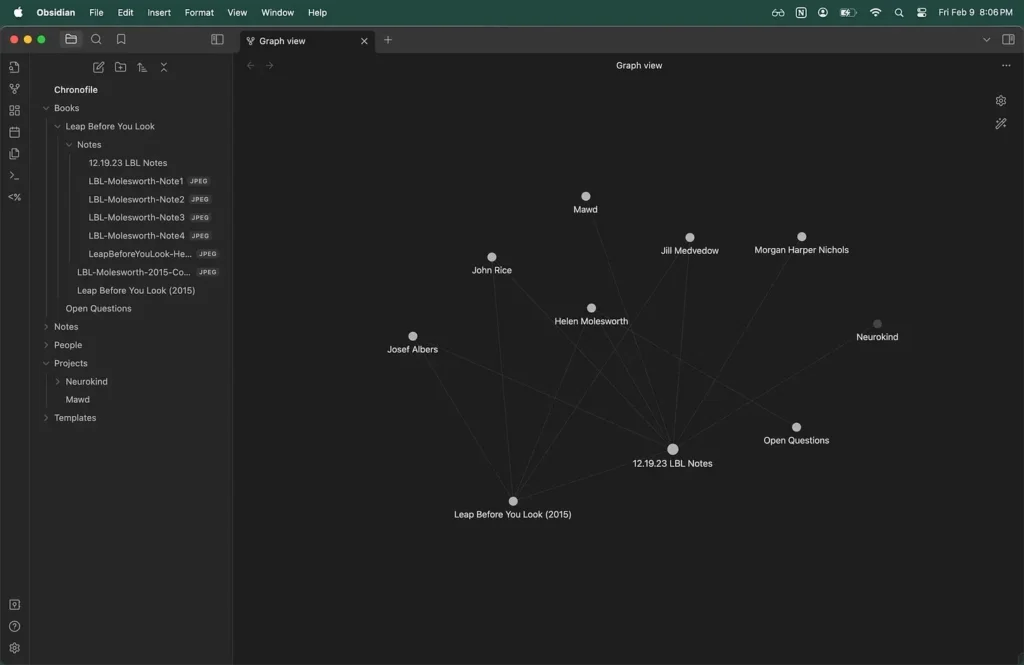
There are lots of aesthetic reasons I’m really enjoying the app, but from a practical side it makes sense too. Instead of uploading your data into an app you’re creating text files and nesting folders on your own computer.
This means if Obsidian goes defunct you’ll still have all of your notes.
And that’s the main reason I’m transitioning away from Notion.
The stars are just a bonus. 💫
Still here? You must be a creative kindred.
How do you collect notes and information?
Do you prefer analogue or digital or a bit of both?
Thanks for being here.
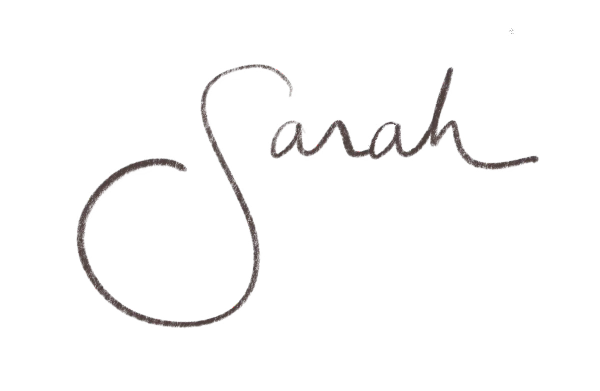
FOOTNOTES
- I might have stuck with this one for simplicity sake, but around this time the paper and binding quality of composition notebooks went right down. I still remember the gummy goo of one particular notebook binding that peeled up. *shudders*
2. At least it is for me. Kudos to you if you’ve figured it out.
3. After watching every single one of the Vlogbrother’s videos I finally read John Green’s The Fault in Our Stars. And it felt like reading a book by a friend. I could see all of the random obsessions he’d had over the years come together in his book. The same for Hank Green’s An Absolutely Remarkable Thing.
4. Dymaxion Chronofile:an archive of nearly every day of Buckminster Fuller’s life. Atlas Obscura. July 11, 2013.
5. Study shows stronger brain activity after writing on paper than on tablet or smartphone, University of Tokyo, March 19 2021.